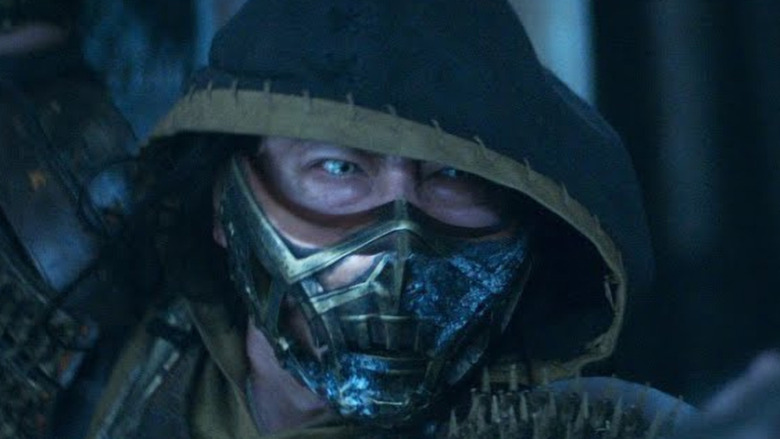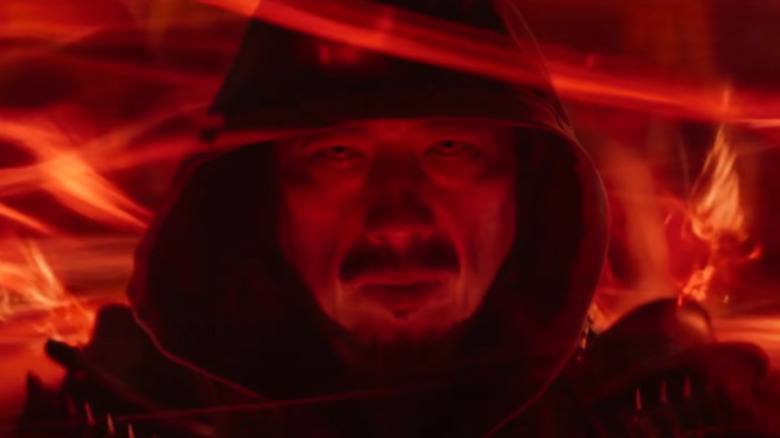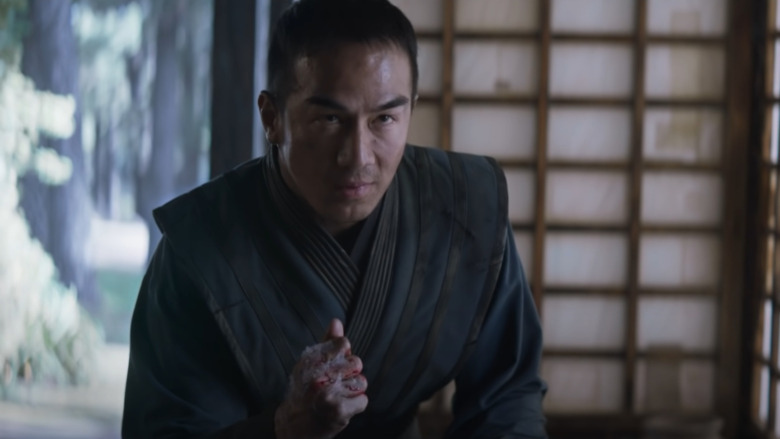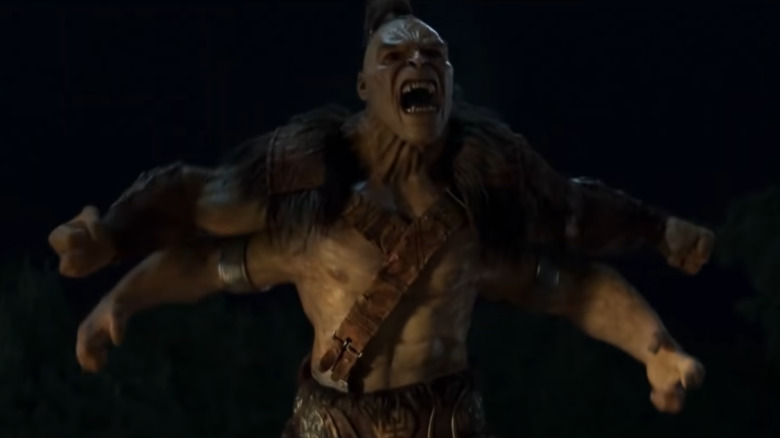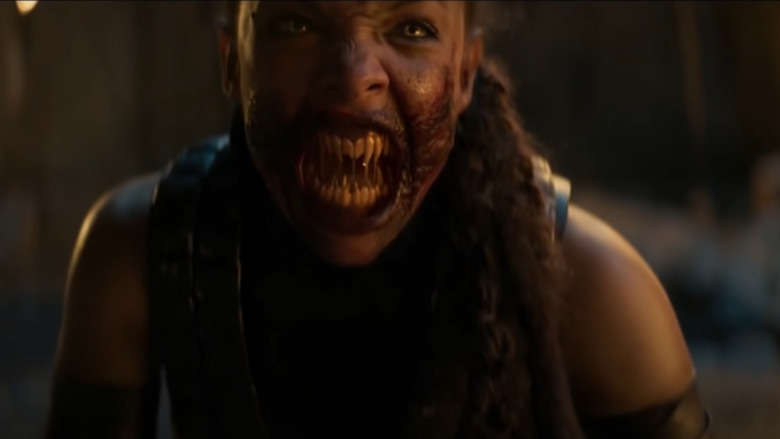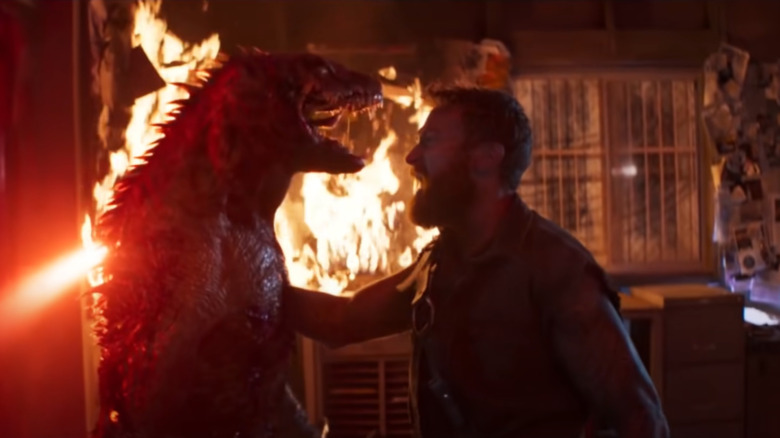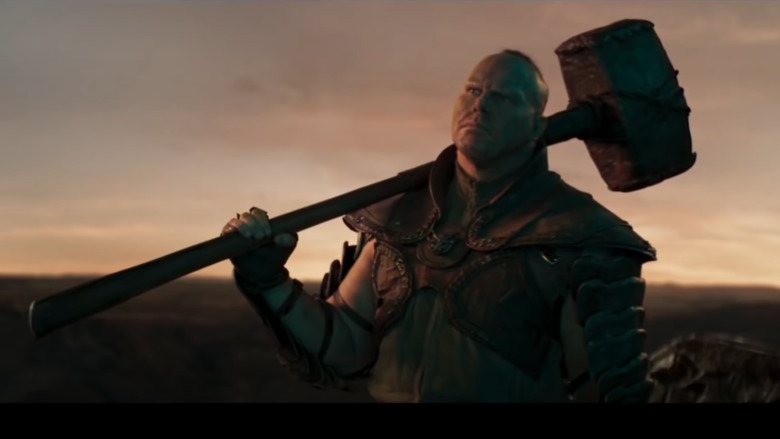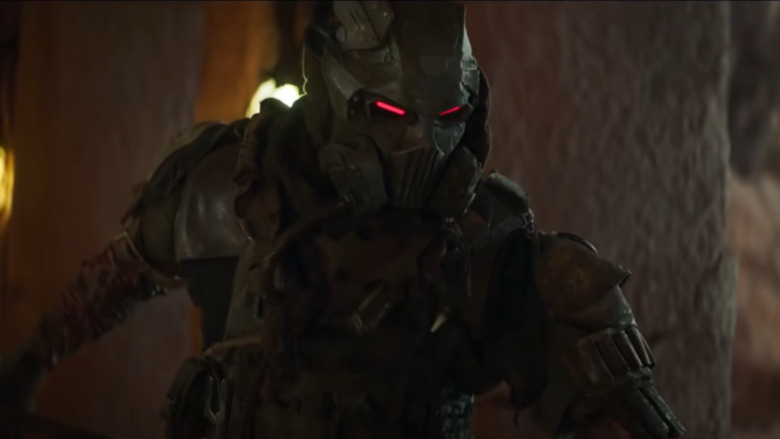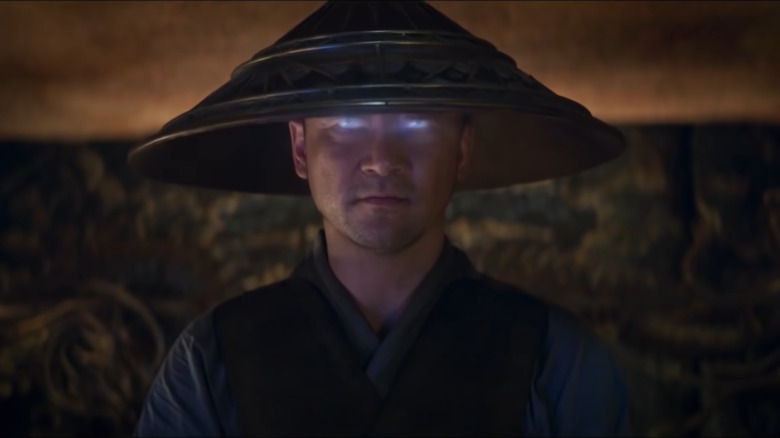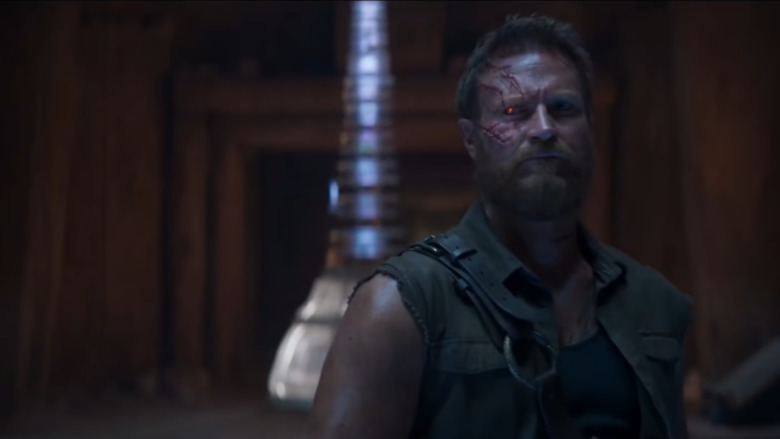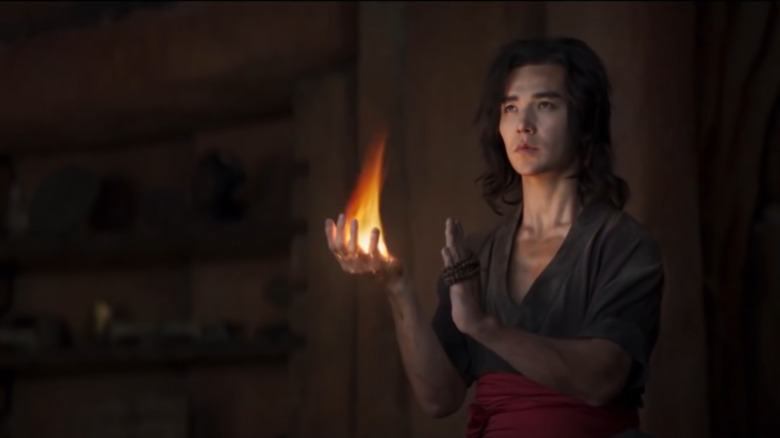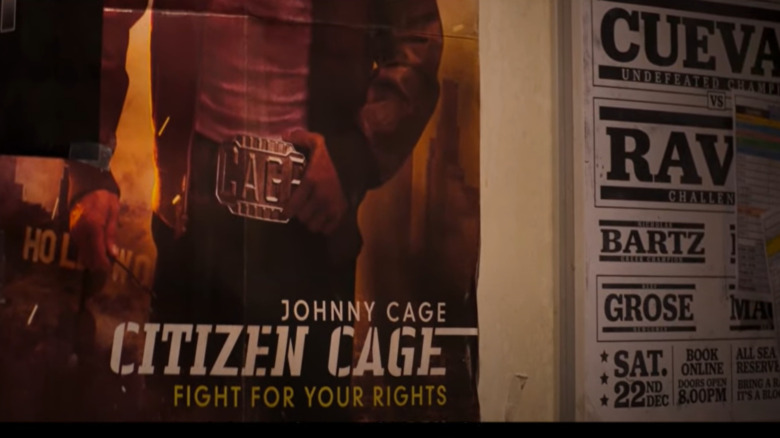Characters In Mortal Kombat With More Meaning Than You Realize
How you feel about 2021's "Mortal Kombat" movie largely depends on your relationship with the video game franchise it's adapted from. Hardcore "Mortal Kombat" fans might appreciate the R rating, which allows for a plethora of fatalities, but might also have problems with the film's general lack of faithfulness to the games' storyline. Casual viewers might find the level of gore off-putting, but could also appreciate the stripped-down narrative.
It's clear that the makers of "Mortal Kombat" aren't concerned with directly translating the games to the screen, or remaking the 1990s movies. But fans with deep knowledge of "Mortal Kombat" lore do have unique insight into the film — especially when it comes to its eye-catching characters. Not one of those fans yourself? Not to worry: We're here to break down some of the hidden meanings of the characters in "Mortal Kombat." Consider that a warning, those of you who haven't seen the movie yet: This article is going to be very full of spoilers!
Scorpion
A lot of the characters we're talking about here are dead by the end of the movie. However, that's not even going to come close to stopping us from speculating on where they might show up next: In the games, characters come back from death all the time, and, as Shang Tsung says, "death is only another portal." Indeed, "Mortal Kombat" makes the fickle nature of death explicitly clear when feudal Japanese ninja Hanzo Hasashi, murdered by rival Bi-Han in the opening scene, returns in the climax as the undead warrior known as Scorpion.
Scorpion's backstory in the movie is almost exactly the same as it is in the games. References to the feuding ninja clans of the Shirai Ryu and the Lin Kuei suggest the films could be interested in exploring this aspect of games in more detail. If so, this opens up a long list of future characters to potentially include: Scorpion trainee Takeda Takahashi, his father, Kenshi Takahashi, fellow Shirai Ryu warrior Forrest Fox, and other Lin Kuei ninjas like Smoke, Sektor, Cyrax, and Frost. This is all subject to change, of course, given the centering of Scorpion's descendant and the film's protagonist, Cole Young. And, of course, Scorpion himself is still wandering the land of the living. There are any number of directions he could go, based on his story in the games.
Sub-Zero
Bi-Han has his own "Mortal Kombat" codename, as fans know well: Sub-Zero. However, this is somewhat misleading. While a character named Sub-Zero appears in every "Mortal Kombat" game, there's only one game in which that character has actually been Bi-Han. In fact, Bi-Han hasn't been Sub-Zero since the very first "Mortal Kombat" — he's killed by Scorpion immediately afterward, and the mantle of Sub-Zero is taken up by his more heroic younger brother, Kuai Liang, in "Mortal Kombat 2." So, while the film's Sub-Zero is the original version of the character, he's technically not the version we've been using to frustrate our friends since 1993.
As he does in the games, Scorpion kills Sub-Zero at the end of the new movie. But Joe Taslim, the actor who plays Bi-Han, is reportedly signed on for four more films. Between that and the fact that his body is collected by Shang Tsung's mysterious teleporting smoke before the credits roll, he's guaranteed to be back for a sequel. Moreover, while he's only Sub-Zero in the first installment, Bi-Han is hardly absent from the remainder of the video game series. In 2004's "Mortal Kombat: Deception," it's revealed that the sinister undead wraith known as Noob Saibot, who debuted in "Mortal Kombat 2," is actually the resurrected spirit of Bi-Han. "Mortal Kombat" screenwriter Greg Russo has already acknowledged that Bi-Han's transformation into Noob Saibot is part of his plan for the character -– though we'll see if he keeps the admittedly stupid name.
Goro
Considering Goro's status as one of the strongest and most popular "Mortal Kombat" characters, it's somewhat surprising to see the four-armed warrior prince of the half-dragon Shokan species show up just long enough to be defeated and killed by Cole. Given the enigmatic black smoke that claims his body, however, he'll likely be back in some capacity.
As "Mortal Kombat" fans know, Goro's character offers the filmmakers many options going forward. If they want to spend more time in Outworld, the realm the movie's villains call home, Goro could be an entry point for that. Viewers could also potentially learn more about the Shokan race, and even about their rival species, the scorpion-like Centaurians. Most tantalizingly, Goro eventually joins the side of the heroes in the video games. But let's be honest: Assuming these movies eventually get to the actual Mortal Kombat tournament, it would make the most sense for a returning Goro to reprise his iconic role as the undefeated champion of Mortal Kombat.
Mileena
Mileena is the most notable Tsung minion who doesn't get expressly set-up for future sequels via black smoke of destiny. One of the franchise's most popular characters, she does get more screen time than Goro, but still ends up with a gigantic hole through her torso by the film's conclusion. It would be surprising if Mileena didn't make it into the sequels in some form, and her video game origin as a hybrid clone lends itself well to an explanation for her return. But even if Mileena doesn't return, her presence in the film still carries a whole lot of weight.
When Mileena first appeared in the "Mortal Kombat" trailer, some fans expressed consternation at what seemed to be the relative normalcy of her face. By the end of the film, those fans were likely pacified, since she does eventually break out the monstrous, sharp-toothed grin she's known for. This act of fanservice could also be an indicator that the Tarkatan race (Mileena being half-Tarkatan) will appear in future installments, most likely in the form of Baraka, whose massive teeth and wrist blades have been part of the franchise since "Mortal Kombat 2." Of course, the other half of Mileena's genes come from her "twin sister," Kitana, a major heroic character curiously absent from the new movie. Should Kitana appear in a sequel, she might introduce her home realm, Edenia, into the film's mythology.
Syzoth and Nitara
Somewhat early in the film, Shang Tsung sends somebody called Syzoth to attack Earth's heroes. This character turns out to be a fiendish reptilian creature, boasting wicked claws and the power to turn invisible. In the games, Syzoth is actually known as Reptile, and is the first secret character in fighting game history. Though he was originally just a green version of the Scorpion/Sub-Zero character template, he eventually gained actual reptilian form, and a backstory to boot. He's the last surviving member of the Saurian species, who have the ability to turn invisible or take human form.
Nitara is another minor character who pops up in "Mortal Kombat," representing one of Outworld's alien species. She only shows up for a couple minutes, and it's unclear how much of her video game origin we're meant to infer. In the games, she's a vampire — that is to say, a member of a vampiric alien species that needs blood to survive. She and Reptile also have a history together in the games. Since Nitara gets eviscerated by Kung Lao in the movie, while Reptile gets his heart ripped out in the trailer, their film-based future isn't looking so good. Still, it's very possible that their respective species will play some role in the franchise down the line.
General Reiko
Goro and Mileena are two of the most notable "Mortal Kombat" characters, Reptile has a cult following, and even Nitara has the benefit of being a traditional vampire. But only the most die-hard "Mortal Kombat" junkies remember Reiko, who was created as a thinly re-skinned Noob Saibot replacement for "Mortal Kombat 4" and has barely appeared in the games since. In the movie, Nathan Jones faithfully embodies Reiko's one major character trait: He owns a hammer.
Even if the movie just needed a low-level side character who could be killed off via Jax Briggs fatality and never seen again, the inclusion of Reiko is a strange choice. Fans can't help but wonder if Reiko is meant to foreshadow the arrival of central "Mortal Kombat" villain Shao Kahn, the emperor of Outworld. For one thing, there's no world in which Shao Kahn doesn't eventually show up, especially given Shang Tsung's parting line about armies. He's also the only other character Reiko is strongly associated with.
The sole thing Reiko has ever been known for is the brief period of time in which some fans were convinced that he and Shao Kahn were the same person. This is due to Reiko's ending in "MK4," which sees him walk into the emperor's throne room and put on his helmet. However, this theory has been debunked, and "Mortal Kombat: Deception" clarifies that Reiko just likes to sneak into the throne room and put the helmet on because he's a weirdo.
Kabal
The last of Shang Tsung's minions, Kabal gets a character makeover in the movie. He still sports his trademark hookswords, mask, and respirators, and is still an ex-member of the Black Dragon mercenary organization. But he's also unambiguously villainous, as opposed to a reformed criminal. He's more well known than characters like Reiko and Nitara, but still obscure enough that he's probably dead for good. However, his presence in the film, as well as his interactions with the Black Dragon leader, Kano, suggest that the "Mortal Kombat" movies might bring in some other Black Dragon-related plot elements and characters. Minor characters like Kira, Kobra, Jarek, and Tremor have all been part of the Black Dragon, which at one point in the game was under Kabal's leadership.
This being "Mortal Kombat," the Black Dragon naturally has an opposite: The Red Dragon, its rival and parent organization, a full-fledged crime syndicate whose inclusion in the films could provide a entry point for villains like Hsu Hao and Mavado. The Red Dragon is also a gateway to some of the larger-scale lore of the "Mortal Kombat" series. After all, the Red Dragon was created by an Edenian half-god named Daegon, and was named after an actual red dragon. Indeed, dragons play a pivotal role in "Mortal Kombat" mythology, which is why the franchise's symbol remains the image of a dragon to this day.
Raiden
If you're going to talk about the mythology of "Mortal Kombat," you have to talk about the lightning god in the room. Raiden was always going to be part of any "Mortal Kombat" movie, but the fact that he's alive and in charge by the end of this one suggests he will continue to be a major part of the next one as well. There's a deep well of lore to be drawn from when it comes to Raiden. The film stays pretty vague about what exactly is going on at the highest levels of this universe, but the phrase "Elder Gods" is mentioned, and it's significant. Raiden himself moonlights as an Elder God, joining and leaving their ranks throughout the series. More importantly, any potential interest the filmmakers may have in the Elder Gods will lead them to another major "Mortal Kombat" villain: The fallen Elder God, Shinnok. In fact, Shinnok's signature amulet of power can be seen in Raiden's temple in the movie, suggesting that, as in the games, Raiden defeated him centuries ago -– though the threat of a revived Shinnok is always in play.
As is the case with many"Mortal Kombat" characters, there are several directions the film version of Raiden could go, including the angry and corrupt "Dark Raiden." But more broadly, if the new movies intend on using any aspect of the franchise's mythology, you can bet that Raiden will be at the heart of it.
Kano
If there's one thing about the movie most "Mortal Kombat" fans probably agree on, it's that Josh Lawson's Kano is absolutely one of the best things about it. While the leader of the Black Dragon mercenaries is oddly placed on the side of the heroes throughout the first part of the film, he turns on them halfway through. Lawson is a delight every time he's on screen, which makes it a bit of a bummer that Sonya kills him with a lawn gnome prior to the end of the movie.
However, there's reason to think this isn't the end for Kano. For one thing, it would seem counterproductive to just cut bait on Lawson after he stole the show so completely. For another, there's the matter of his face, scarred in his fight against Reptile. In the games, Kano is cybernetically enhanced, bearing a metal faceplate pretty much exactly where Reptile's claws raked him. That's also the same eye Sonya drove the gnome through — an eye that, in the games, is cybernetic and shoots lasers. The movie, hilariously, has Kano spontaneously manifest this power thanks to the dragon marking he bears, but that marking is taken by Sonya when she kills him. Bringing Kano back as a cyborg would align with his video game origins, provide a new source for his eye beam, and most importantly, keep Lawson in the franchise.
Liu Kang
There's a reason that the film's insertion of Cole Young, an original character not present in the video games, has caused so much bafflement among fans of the franchise: "Mortal Kombat" already has a main character. Liu Kang, originally conceived as a Shaolin monk, can be considered the primary hero of the entire series, and most adaptations place him in that role. Robin Shou plays him in the two '90s movies, and there's never any question about who the protagonist of those films is. It's decidedly odd to see another character in Liu Kang's place, and especially strange to see Liu Kang show up in the movie anyway, in a secondary role.
Unlike his mentor, Kung Lao, Liu Kang makes it to the end of the film. It's possible that he will ascend to main character status at some point in the future — perhaps the filmmakers decided to include Liu Kang as a sort of fail-safe, if the audience reaction to Cole is less than positive. But even if that never happens, Liu is already dropping hints about other portions of the "Mortal Kombat" universe he could unlock, such as his name-dropping of Bo' Rai Cho, master of the Drunken Fist.
Johnny Cage
Technically, Johnny Cage doesn't appear in the new "Mortal Kombat" movie. This was an intentional decision, according to director Simon McQuoid, who believed Cage would "throw it out of balance slightly." However, there's a direct reference to Cage in the movie's final shot, as the camera lingers on a poster for a fictional film entitled "Citizen Cage," starring Johnny himself. This comes directly after the victorious heroes agree they need to find more fighters before their next battle, and after Cole informs us that he's headed to Hollywood to track one such fighter down. It's the movie's only direct suggestion of a sequel, teasing us with the potential arrival of one of the franchise's biggest names.
One of the original "Mortal Kombat" characters, Cage is an iconic part of the series. A cocky martial artist and actor, he enters the tournament to prove he does his own stunts. He's also famous for being Sonya Blade's love interest. As McQuoid put it, Cage "almost has his own gravitational field," and it's true that he would cast a sizeable shadow over a "Mortal Kombat" sequel. But at this point, that's not a bad thing — the new movie diverges so thoroughly from continuity that a little familiarity would be welcome in a sequel.
